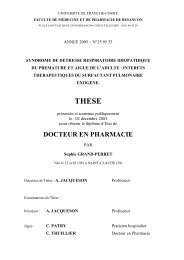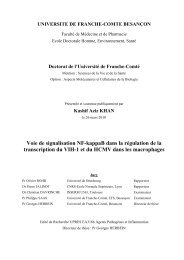THÈSE - Université de Franche-Comté
THÈSE - Université de Franche-Comté
THÈSE - Université de Franche-Comté
Create successful ePaper yourself
Turn your PDF publications into a flip-book with our unique Google optimized e-Paper software.
Summary<br />
1. Small mammals are the most important vertebrate pests in Central European agriculture. In<br />
Western continental Europe, cyclic outbreaks of Arvicola terrestris populations have caused<br />
dramatic grassland damage since the 1970s. One explanation could be that intensive<br />
agriculture has created homogeneous grassland ecosystems with a high risk of outbreaks.<br />
While the role of the landscape structure on A. terrestris outbreaks has been i<strong>de</strong>ntified on a<br />
large scale, little is known about the quantitative effects of grassland management on a local<br />
scale. We aimed to investigate the impact, on a parcel scale, of farming practices on the A.<br />
terrestris population increases, in or<strong>de</strong>r to i<strong>de</strong>ntify which practices may significant affect<br />
population changes and how they could be used to minimize the risk of outbreaks.<br />
2. We examined different phases of an A. terrestris population cycle in agricultural parcels :<br />
low <strong>de</strong>nsity, increase and high <strong>de</strong>nsity. For each parcel, relative abundance of A. terrestris<br />
were estimated by an in<strong>de</strong>x method. Talpa europaea populations were also taken into account,<br />
as they may play an important role in the early stages of A. terrestris population increases.<br />
Farmers were interviewed about their land-use practices related to fertilisation, mowing, soil<br />
work and grazing.<br />
3. Farming practices significantly influenced A. terrestris populations. Intensive farming<br />
practices (organic fertilisation and mowing) stimulated an early and more rapid growth of the<br />
A. terrestris population. In contrast, disturbances such as grazing and soil work were<br />
unfavourable to the abundance level of the A. terrestris population at the high <strong>de</strong>nsity phase.<br />
4. During increase phase, the A. terrestris populations reached higher abundance levels in the<br />
parcels where the relative abundance of T. europaea were initially higher.<br />
5. Synthesis and applications. Habitat manipulation by land managers offers a promising<br />
alternative in more integrated control of A. terrestris outbreaks. We outline that practices<br />
indirectly disturb populations, such as grazing and ploughing dampened population dynamics<br />
in more heterogeneous agrosystems. Thus, rethinking the spatial arrangement of grazed,<br />
ploughed and mowed parcels may be an effective way to stabilize populations and facilitate<br />
the implementation of other control methods (e.g. trapping or chemical ro<strong>de</strong>ntici<strong>de</strong>s). We also<br />
recommend controlling T. europaea and A. terrestris populations at low <strong>de</strong>nsity phase.<br />
Thèse C. Morilhat 2005 98









